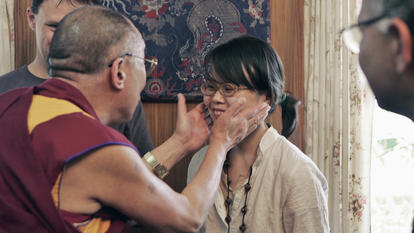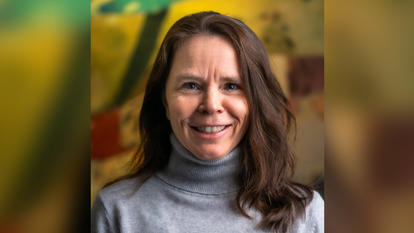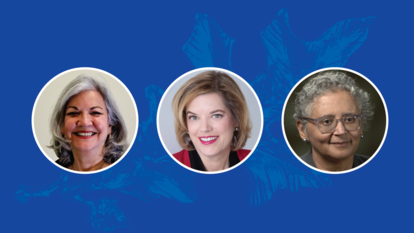
The Fight for—and Against—the Vote
Today marks 100 years since the adoption of the 19th Amendment to the U.S. Constitution, giving most women the right to vote. As we celebrate this milestone, and as Wellesley turns its focus to the start of classes, it is also an opportunity for our community to revisit #WellesleyVotes, a nonpartisan initiative that demonstrates our shared commitment to democracy and to encouraging students to vote.
This semester, #WellesleyVotes will offer virtual programming that brings together activists, journalists, and academics—including Wellesley alumnae—in conversation with students, staff, and faculty to address issues that are on the ballot this November, such as economic and racial inequality, women’s health, criminal justice, and gender equity.
The initiative will also highlight the work of Wellesley community members in the political, public, and personal spheres that furthers conversations on these issues and others as they relate to voting rights, equity, and outreach.
We begin with the following excerpt from The Fight for—and Against—the Vote, written by Amita Parashar Kelly ’06 for the summer 2020 edition of Wellesley magazine, which serves as a reminder of the challenges the suffragists faced, and why the right to vote should not be taken for granted.
Imagining the lives of American women more than 100 years ago feels almost dystopian. Maybe you were one of the lucky ones—born white and wealthy enough to live a mostly comfortable life, though still with little autonomy. Maybe you came of age when colleges like Wellesley opened, and you were able to access higher education. Maybe you worked in one of the limited jobs available to women, earning a fraction of what a man would have made for the same work. If you were married, any property, wages, or inheritance you earned could belong to your husband—because you did not exist separately from him. If you were Black, the fresh legacy of slavery still barred you and your family from nearly every right and benefit of society.
Put simply—legally, politically, and economically, women were not considered individuals.
Until they fought back.
“If we have a responsible share in government, we shall ourselves profit in growth of power and character, and we shall be more intelligent and loyal citizens. … Womanhood is getting restless under its stigma of irresponsiblity,” reads a 1912 notice for the Equal Suffrage League in the Wellesley News.
By the 1910s, the College and the nation were approaching the finish line in the fight for suffrage—and women were restless indeed. A fight more than seven decades in the making culminated in August 1920, 100 years ago, with the ratification of the 19th Amendment to the Constitution, which guaranteed most women the right to vote nationwide. (It would still be decades before millions of women of color could exercise full voting rights in practice.) The amendment boils down to just 28 words: “The right of citizens of the United States to vote shall not be denied or abridged by the United States or by any state on account of sex.”
When Wellesley opened its doors in 1875, the suffrage movement was already humming. The first women’s rights convention was convened in Seneca Falls, N.Y., about 25 years earlier—ending in the forceful declaration that “because women do feel themselves aggrieved, oppressed, and fraudulently deprived of their most sacred rights, we insist that they have immediate admission to all the rights and privileges which belong to them as citizens of these United States.”
Beyond Seneca Falls, there were small movements popping up across the country—including by women of color—to lobby states to allow women to vote. Women were beginning to break out of their prescribed roles and step into every corner of society.
By the early 1900s, Wellesley’s campus was already awakening to the suffrage movement, and faculty and alumnae were involved in local and national chapters of suffrage leagues, according to news reports and notices from the time.
In 1902, students were invited to participate in an essay competition by the College Equal Suffrage League—a fundamental part of the movement that was created by two Radcliffe alumnae to attract younger participants.
Wellesley had its own chapter of the Equal Suffrage League, which frequently advertised open meetings in the Wellesley News. The notices are a window into the start of student activism at Wellesley. “We have our contribution to make to the government, as well as to the census, and we shall not be less admirable women because we are more efficient citizens,” read one notice.
“It should be the joy of every woman to believe in the capacity of her sex,” read another.
Perhaps the most visible demonstrations of the movement were the marches and parades—comprised of rows of women in long white dresses, often with sashes and signs reading “Votes for Women,” and some men. The Wellesley community participated in several such parades leading up to the passage of the 19th Amendment.
Wellesley student E. Eugenia Corwin 1914 wrote of attending a suffrage parade on May 2, 1914—a day when coordinated parades were held across the country, including a large one in Boston. The parade, she said, “meant not only the music and banners and swing of a great procession, but inconvenience, long waiting, a hard march. It gave us, in a very small way, a chance to sacrifice something to a noble idea.”



